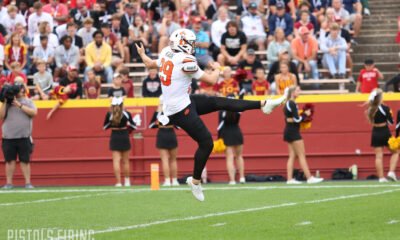Hoops
State of the Program: An Offseason Checklist for Mike Boynton, OSU Basketball
Five things OSU needs to look at this offseason.

A season that at times showed promise fizzled with a fury on Tuesday as OSU basketball fell 65-59 in overtime to North Texas in the NIT, raising questions about what went wrong and how Mike Boynton and his staff can make things right moving forward. A loss in the NIT isn’t enough to raise alarm bells, of course, but failing to make the NCAA Tournament — and struggling to field a competent offense — certainly adds to the challenge OSU faces this offseason.
So let’s dissect with an offseason checklist — a season postmortem if you will — to recap what went wrong and how things can be righted.
1. Find shooters
The 2022-23 season ended in fitting fashion with OSU failing to find success shooting from distance and struggling to find consistency from the free-throw line. The final numbers on the season are pretty jarring to look at, too. Here’s how OSU ranked this season — and in the last five previous seasons — as a 3-point shooting team contrasted with the rest of the league.
2022-23: Ninth (out of 10)
2021-22: 10th
2020-21: Eighth
2019-20: Eighth
2018-19: First
Somehow the worst team of the last five seasons was also the best at launching 3s. There doesn’t appear to be any correlation there, though. OSU needs to find players who can shoot it at a high level from distance on a consistent basis to improve the baseline upon which the offense is built. Plain and simple.
2. Establishing a lead guard
OSU has done an excellent job of identifying, developing and nurturing combo guards who can do a little creating and a little shooting while adding length and athleticism defensively. That has also been largely at the expense of developing a true lead guard who can run the offense. Kind of like the whole If you have two quarterbacks you have none mantra, it feels a lot like If you have a ton of combo guards who are versatile you don’t have a lead guard who can control the pace and game and therefore you might not be all that good at running an offense. Wordy, but it fits, right?
OSU’s best team of the Boynton era had this figured out — Cade Cunningham dominated usage on the ball — and while No. 1 picks don’t exactly grow on trees, the concept of what Cunningham represented still fits. He could run the show and helped OSU to its fastest tempo of the Boynton era. To get back to the NCAA Tournament that seems to be what OSU needs to get back to.
3. Embracing the 3
This goes hand-in-hand with points No. 1 and No. 2 and continues what appears to be an obvious trend for OSU it needs to adapt. OSU’s distribution of points that come from the 3-point line rated almost dead last in the country last season and has ranked in the 200s or 300s for the last few seasons. This may be by design or by necessity, of course: OSU hasn’t fixed point No. 1 and therefore cannot adapt to point No. 3. You can’t separate the two. But the most successful teams in college basketball the last few years — Villanova and Alabama, for instance — are largely relying on analytics that dictate the best shots are either layups or 3s. If you can’t do the latter at a high level and with frequency it’s hard to see a path to establishing a successful offense in the modern era.
4. Taking care of the ball
OK, so another checklist item that probably goes hand-in-hand with another point. Sue me.
OSU needs to commit less turnovers and take better care of the ball. That can’t be done without addressing point No. 2. You can’t ignore just how problematic that has been for OSU on the whole and especially for its offensive success (or lack thereof). OSU finished the season last in the Big 12 in turnover rate this season for a second consecutive year. Creating offense — in the halfcourt especially — is a painful viewing experience because half the possessions seem to end in a fumbled exchange or an errant pass. You can’t run the Daxx Garman offense and expect good results.
5. Starting better
In two of the last five seasons, OSU has failed to make the NCAA Tournament owing at least in part to slow starts — either in conference play or in nonconference play.
In 2017-18, it was a bit of both: OSU finished as a No. 2 seed in the NIT despite a relatively strong finish to the season after falling to Texas A&M on a neutral and to Wichita State at home in non-league play and after opening Big 12 play 3-6.
In 2022-23, OSU finished as the No. 1 seed in the NIT, and it had only itself to blame after taking horrendous losses to start to the year to Southern Illinois and to UCF. That only got worse to start the conference slate as OSU stumbled to a 1-4 start before finishing 8-10.
It’s easy to say simply win games you lost and — voila — problems solved. Which, honestly, would solve things. But there’s a pattern of shortcomings for this team the last few years as it relates to starting games, starting conference play or starting nonconference play. It’s a good sign that OSU generally seems to improve as the season rolls along and is a testament to the coaching staff’s mettle and development, but not a good sign that it continues to be a thorn in its side.

-

 Hoops4 days ago
Hoops4 days agoFIU Transfer Arturo Dean Commits to Oklahoma State
-

 Hoops3 days ago
Hoops3 days agoTexas Tech Transfer Robert Jennings Commits to Oklahoma State
-

 Golf4 days ago
Golf4 days agoOSU Freshman Preston Stout Sinks Long Putt to Earn Share of Big 12 Title
-

 Football4 days ago
Football4 days agoAustrailian Punter Hudson Kaak Details Transition to Stillwater, Football






